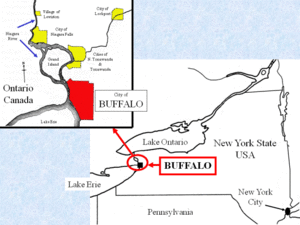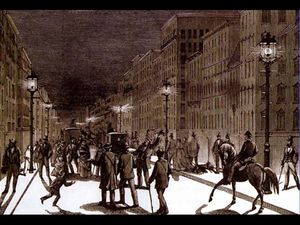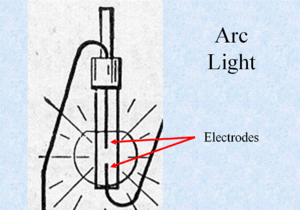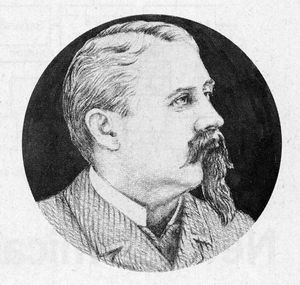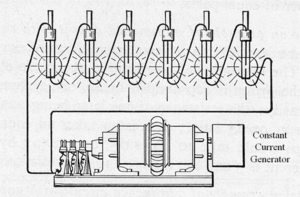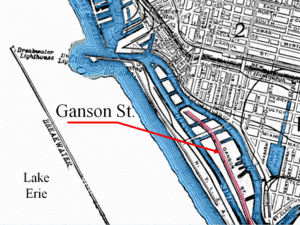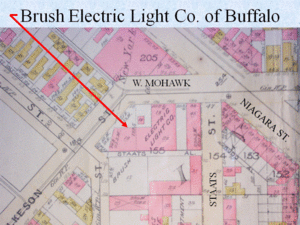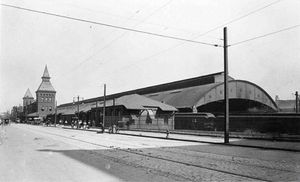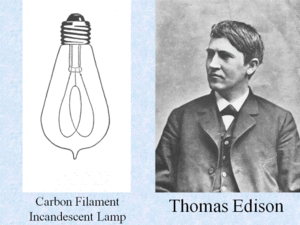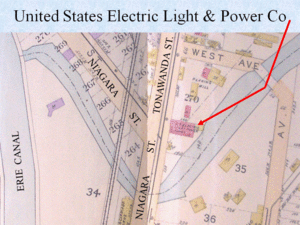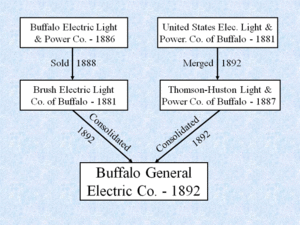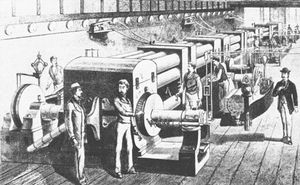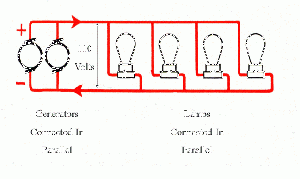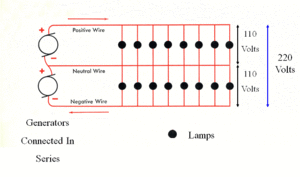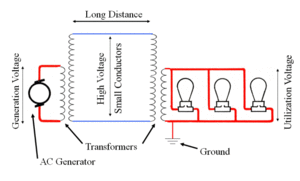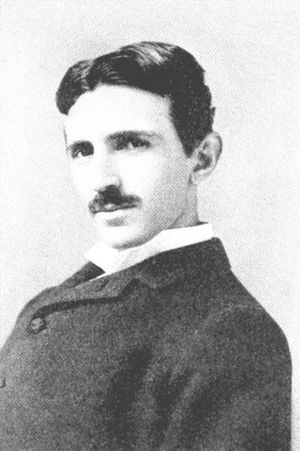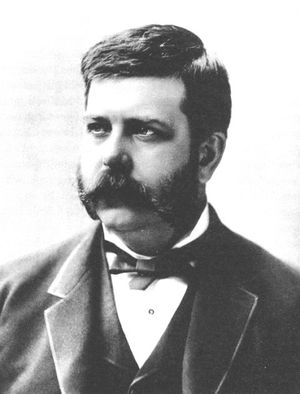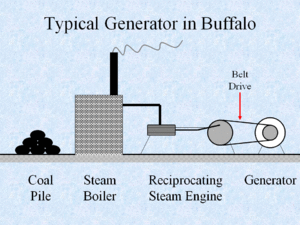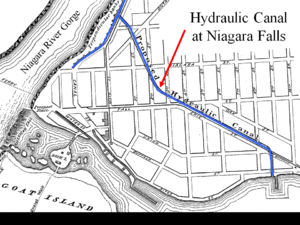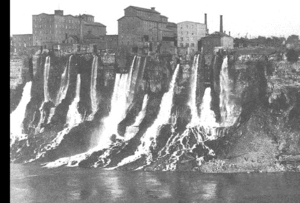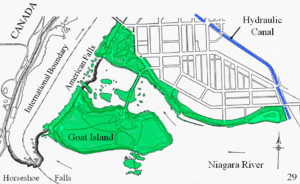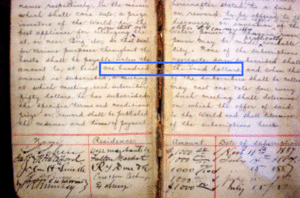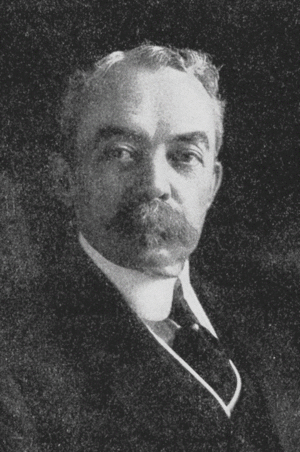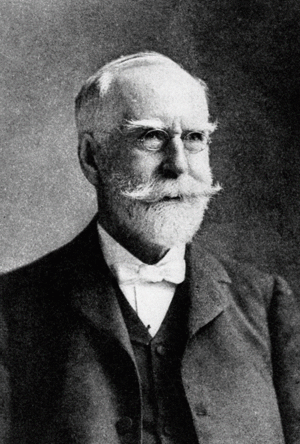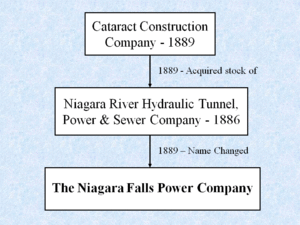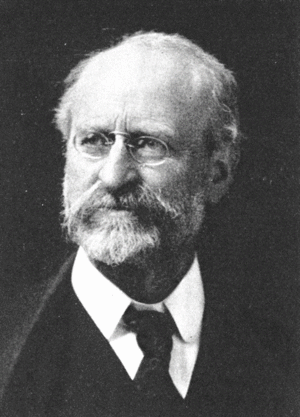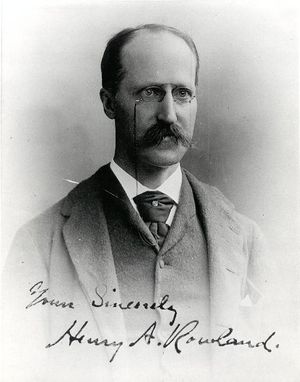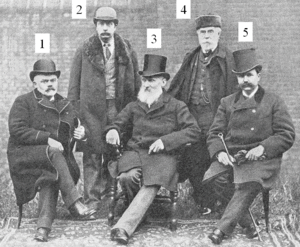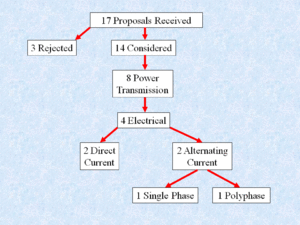Early Electrification of Buffalo: Difference between revisions
No edit summary |
No edit summary |
||
| Line 89: | Line 89: | ||
vii. “The Copper Ring and the Senate Tariff Bill,” New York Times, 30 Nov 1888. | vii. “The Copper Ring and the Senate Tariff Bill,” New York Times, 30 Nov 1888. | ||
== Developing a Renewable Energy Source == | |||
[[Image:03-25 Generator.GIF|thumb|left|Figure 3.1 Typical generator]] | |||
The early Buffalo systems probably all had a common arrangement: a coal fired boiler with a reciprocating steam engine of a couple hundred horsepower maximum, belt connected to a generator that served an area of about a square mile [Fig. 3.1]. What other source of energy was available? | |||
The greatest source of renewable energy on the Niagara Frontier is at Niagara Falls. The energy of the falling water has been estimated at six million horsepower. [[Image:03-27 hydraulic canal.GIF|thumb|right|Figure 3.2 Hydraulic Canal]]The story of the development of the Hydraulic Canal to provide waterpower for industries at the brink of the Niagara gorge and its purchase by the Schoellkopf interests in 1877 will not be repeated here [Fig. 3.2]. Note that the industries used only a portion of the available head of water [Fig 3.3]. [[Image:03-28 industries on the falls cropped.GIF|thumb|left|Figure 3.3 Industries at Brink of Niagara Gorge]] | |||
In 1885 the State of New York acquired all the land for about a mile upstream and a quarter-mile downstream from the American [[Image:03-29 State reservation at niagara falls cropped.GIF|thumb|right|Figure 3.4 State Reservation at Niagara Falls]]Falls plus all the islands for a State park [Figure 3.4]. This removed all the readily available waterpower sites except for the Hydraulic Canal. How could more of this renewable energy be utilized? | |||
[[Image:03-30 evershed plan cropped.GIF|thumb|left|200x90px|Figure 3.5 Evershed Plan (canals in red; tailrace tunnel in green)]]In February 1886 Thomas Evershed, a division engineer on the Erie Canal, developed a plan to construct a series of canals from the Niagara River and sell mill sites on both sides of the canals. [[Image:03-31 evershed plan profile cropped.GIF|thumb|right|240x75px|Figure 3.6 Evershed Plan Profile]]Water would be drawn from a canal, run through a waterwheel and discharged into a tailrace tunnel that would run into the Gorge [Fig. 3.5]. The profile shows the canals and wheel pits [Fiig. 3.6]. A total of 238 mills of 500 hp each could be developed.<sup>i</sup> This would be 119,000 hp or more than the total of all the developed hydropower in eastern New York and New England combined.<sup>ii</sup> | |||
In June 1886 the Niagara River Hydraulic Tunnel, Power & Sewer Co. was organized to pursue the Evershed plan.<sup>iii</sup> It was chartered by the State of New York and later authorized to take water from the Niagara River sufficient to produce 200,000 hp.<sup>iv</sup> [[Image:03-33 One hundred thosand dollar prize cropped.GIF|thumb|left|Figure 3.7 $100,000 Prize]]The Prospectus stated “It is conceded by leading practical electricians that it would be entirely practicable now to light the City of Buffalo (distance 20 miles) with power furnished by Niagara Falls,… An application has already been received from a manufacturer in Birmingham, England, for an opportunity to test his apparatus for conveying power by means of compressed air.”<sup>v</sup> Various attempts to finance the project proved futile. In July 1887 a number of enterprising citizens of Buffalo provided a cash prize of $100,000 for a practical method of using Niagara power in Buffalo [Fig. 3.7].<sup>vi</sup> None of the projects submitted merited the prize. [[Image:03-34 Edward Dean Adams cropped.GIF|thumb|right|Figure 3.8 Edward Dean Adams - attorney, investment banker]][[Image:03-35 Dr. Coleman Sellers cropped.GIF|thumb|left|Figure 3.9 Dr Coleman Sellers - Mechanical Engineer]]In 1889 the ‘Tunnel” company, through attorney William Rankine, got the attention of J. P. Morgan and Edward Dean Adams, a New York City attorney and investment banker [Fig. 3.8]. Adams consulted the renowned mechanical engineer Dr. Coleman Sellers [Fig. 3.9]. Sellers reviewed the Evershed prospectus and informed Adams that the plan was financially feasible.<sup>vii</sup> In December 1889 a syndicate of financiers organized The Cataract Construction Company with Adams as president. The Cataract company acquired all the stock of the “Tunnel” company and would act as its business and financial agent.<sup>viii</sup> [[Image:03-36.GIF|thumb|left|figure 3.10 Niagara Falls Power Company organized]]The Cataract company was designed to represent all the money subscribers to the enterprise and to be the means of their profiting by its contract with the “Tunnel” company for the design and construction of the project. This speculative venture was expected to be slow in developing. The organization of capitalists and engineers became an association of adventurers and pioneers.<sup>ix</sup> In late 1889 the “Tunnel” company’s name was changed to The Niagara Falls Power Company [Fig. 3.10].<sup>x</sup> | |||
Difficulties with the Evershed plan soon appeared. The construction of over five miles of tunnel and 238 wheel-pits practically all by rock excavation in hard limestone indicated the economy of fewer wheel-pits and shorter tunnels and inlet-canals.<sup>xi</sup> Questions arose:<sup>xii</sup> | |||
1. Was the old plan of placing a mill over or near its own water wheel adaptable to a project of unprecedented magnitude, or could power produced at one place be supplied to several customers? | |||
2. Could power be distributed locally or transmitted a considerable distance by shafts or belts or wire ropes, by compressed air or water pressure, or by electricity? | |||
3. Could Buffalo, with a population of 255,000, compared to 5,000 in Niagara Falls, be reached by any practical method? Edison was asked and replied “No difficulty transferring unlimited power.” He proposed connecting several dc [[Generators|generators]] in series at Niagara Falls to obtain 6,000 volts, utilizing underground cable across Grand Island and connecting several dc motors in series in Buffalo.<sup>xiii</sup> Westinghouse advocated compressed air.<sup>xiv</sup> Compressed air had an advantage in that it could be used in place of steam in many existing steam engines.<sup>xv</sup> | |||
[[Image:03-38 Dr Clemens Herschel cropped.GIF|thumb|left|Figure 3.11 Dr. Clemens Herschel - hydraulic engineer]][[Image:Henry Rowland 0459a.jpg|thumb|right|Figure 3.12 Henry Rowland - physicist - Johns Hopkins]]Consultants were engaged including Clemens Herschel, an hydraulic engineer who had extensive experience on American waterpower projects [Fig. 3.11] and Professor Henry Rowland, a physicist from Johns Hopkins University who was to determine if the project was economically feasible [Fig. 3.12]. Professor Rowland reported “.. the practical and commercial problem is of a different nature than the scientific one and may be stated thus: at what distance from cheap water-power can such power, transmitted electrically, compete with steam in cost and certainty of operation?”<sup>xvi</sup> New methods were called for; power was to be produced on an unprecedented scale. Nothing in existence was adequate to accomplish these results.<sup>xvii</sup> | |||
[[Image:03-40 International Niagara Commission cropped.GIF|thumb|left|Figure 3.13 Niagara International Commission (left to right: Mascart, Unwin, Thompson (pres.), Sellers, Turrettini)]]In the midst of all this doubt, the Construction company did what any self-respecting organization does; in July 1890 they formed a committee. But what a committee! It was named the International Niagara Commission and consisted of E. Mascart (Professor, College of France), William Unwin (Professor, Central Institute London, England), Sir William Thomson (later Lord Kelvin; University of Glasgow, Scotland), Dr. Coleman Sellers (Professor, Stevens Institute and Franklin Institute, United States), and Theodore Turrettini (President, City of Geneva, Switzerland and a waterpower engineer) [Fig. 3.13].<sup>xviii</sup> | |||
The Commission investigated the state of the art of power transmission in the United States and Europe and also sent out invitations offering a monetary prize for plans for hydraulic development and power transmission and distribution including 50,000 hp to Buffalo.<sup>xix</sup> Competitors from six countries submitted seventeen proposals. Three were rejected as irregular.<sup>xx</sup> Of the eight projects presented for power transmission, only four proposed electrical methods [Fig. 3.14]. Two advocated direct current and two alternating current; one single phase and one polyphase.<sup>xxi</sup> Westinghouse refused to submit a proposal remarking [[Image:03-41 proposal flowchart.GIF|thumb|right|Figure 3.14 Proposals submitted to the Internalional Niagara Commission]]“These people are trying to secure $100,000 worth of information by offering prizes, the largest of which is $3,000. When they are ready to do business, we will show them how to do it.”<sup>xxii</sup> Prizes were awarded in early 1891. No first prize was awarded for a combined project for hydraulic development and distribution. In the opinion of the Commission, no project could be recommended for adoption without considerable modification.<sup>xxiii</sup> The Commission’s report takes up 53 pages in Volume I of Edward Dean Adams’ book ‘Niagara Power’ and provides interesting reading.<sup>xxiv</sup> | |||
== References == | |||
i. Adams, ''Niagara Power'', 1:116. | |||
ii. Ibid., 141. | |||
iii. Ibid., 120. | |||
iv. Ibid., 119. | |||
v. Ibid., 122. | |||
vi. Ibid., 94. | |||
vii. Jill Jonnes, ''Empires of Light: Edison, Tesla, Westinghouse and the Race to Electrify the World ''(New York: Random House, 2003), 282-283. | |||
viii. Adams, ''Niagara Power'', 1:233, 292. | |||
ix. Ibid., 292, 297. | |||
x. Ibid., 132. | |||
xi. Ibid., 143. | |||
xii Ibid., 142. | |||
xiii Ibid., 144-147. Adams, ''Niagara Power'', 2:171. | |||
xiv. Adams, ''Niagara Power'', 2: 221. | |||
xv. Ibid., 203. | |||
xvi. Adams, ''Niagara Power'', 1:152-156. | |||
xvii. Ibid., 163. | |||
xviii. Ibid., 173. | |||
xix. Ibid., 395. | |||
xx. Ibid., 187. | |||
xxi. Adams, ''Niagara Power'', 2:219. | |||
xxii. Adams, ''Niagara Power'', 1:363. | |||
xxiii. Ibid., 187. | |||
xxiv. Ibid., 413. | |||
[[Category:Energy|Category:Power,_energy_&_industry_application]] | |||
Revision as of 15:52, 18 September 2014
The Beginning of Central Station Service
[NOTE: This is Part 1 of a fourteen part series of articles first developed as a PowerPoint presentation by Craig A. Woodworth, IEEE Life Member (a.k.a Cawoody), for a joint meeting of the Buffalo Section IEEE and the Buffalo & Erie County Historical Society on April 14, 2004.]
See also:
Early Electrification of Buffalo: Advent of Alternating Current (Part 2) Early Electrification of Buffalo: Developing a Renewable Energy Source (Part 3) Early Electrification Of Buffalo: Niagara Falls Hydraulic Development - Adams Station (Part 4) Early Electrification of Buffalo: Adams Station - Electric Development (Part 5) Early Electrification of Buffalo: Niagara to Buffalo Transmission Lines (Part 6) Early Electrification of Buffalo: Electricity Distribution Within Buffalo (Part 7) Early Electrification of Buffalo: Early Power Company Interconnections (Part 8) Early Electrification of Buffalo: Niagara Falls Water Diversion Limitations Result in Steam Station Construction (Part 9) Early Electrification of Buffalo: Hydroelectric Reorganization to Increase Efficiency (Part 10) Early Electrification of Buffalo: Types of Electric Service available in Buffalo (Part 11) Early Electrification of Buffalo: 60-Hz Replaces 25-Hz (Part 12) Early Electrification of Buffalo: Contributions of Five AIEE Presidents (Part 13) Early Electrification of Buffalo: 1925 Residential Electric Bill (Part 14)
The City of Buffalo is located in western New York State at the junction of Lake Erie and the Niagara River. It is approximately ten miles north-to-south and six miles east-to-west with an area of 42 square miles. Niagara Falls is located 20 miles north of the city [Fig. 1.1]. In 1900 Buffalo, with a large commercial and industrial base, was the eighth largest city in the United States.
Buffalo, the Queen City of the Lakes, was an up-to-date city at the end of the 19th century and electric lights were in the forefront. "I went to the city to see the great sights and there I saw what they call ‘lectric lights. Now I think I know what I’m talking about ‘cuse they put them up in bottles and you can’t blow them out.”i [Fig. 1.2]
The earliest electric lights were arc lights.ii The electric discharge between two carbon or other type electrodes gave a brilliant light suitable for lighting streets, large stores and halls but not homes [Fig. 1.3].iii Arc lights for street lighting were usually on constant-current series circuits [Fig. 1.4].
Charles Brush was a pioneer in the development of arc lights [Fig. 1.5].iv In July 1881 the Brush
Electric Light Company of Buffalo installed the first electric plant in Buffalo on Ganson Street along the City’s waterfront [Fig. 1.6].v A 30-hp steam engine driving a generator with a capacity of forty 2,000-candlepower arc lamps supplied twelve carbon arc lights extending a mile along the street. In August a second station was built in the New York Central Railroad’s Chicago St. roundhouse supplying thirteen arc lights in the Exchange Street Depot [Fig. 1.7]. A third station was added in 1882 at Wilkeson and Mohawk Streets near the present City
Hall to extend arc lighting service to many other streets, churches, public meeting places, hotels and other business places [Fig. 1.8]. The Buffalo Electric Light and Power Company also had its machines installed at Brush’s Wilkeson Street Station. This location was used as an electric company station for 120 years.
In October 1881 the United States Electric Lighting Company gave a lighting exhibition in a factory building at 296 Washington Street and installed ten lamps in the J. N. Adams store in November. In 1883 this company placed two direct current machines in Brush’s Wilkeson Street Station for the first incandescent lamps
installed in Buffalo.vi Edison had developed the first practical electric incandescent lamp four years earlier [Fig. 1.9].
Other companies joined the lighting rush. In 1885, the United States Electric Light and Power Company of Buffalo had a plant for arc lighting in the Black Rock section of the City [Fig. 1.10].vii In 1887, the Thomson-Houston Light and Power Company of Buffalo had a plant for arc lighting located on Effner Street and later moved downtown to 40 Court Street.viii
The Buffalo General Electric Company was formed August 1, 1892 as a consolidation of the Brush Electric Light Company of Buffalo and the Thomson-Houston Electric Light and Power Company of Buffalo, which had combined with two of the previously mentioned companies [Fig. 1.11].ix Next: Part 2 of 14: Early Electrification of Buffalo: Advent of Alternating Current
References
i. A ditty repeated in the author’s youth by his father Harry Woodworth (1893-1970).
ii. “Engineering the Electric Century: Arc lights create first surge of demand for electricity on large scale,” Electrical World, March 15, 1973: 30-31.
iii. Alfred Morgan, First Electrical Book for Boys (New York: Charles Scribner’s Sons, 1940), 128.
iv. “Giants of the Electric Century 1874-1974: Charles Francis Brush, Pioneer of electric arc lighting” Electrical World, May 1, 1973: 35.
v. Niagara Mohawk Power Corporation. The Niagara Mohawk Story (1823-1983): A Reference Manual of 160 Years of Niagara Mohawk Power Corporation and its Predecessor and Associated Companies, 2d ed. (Niagara Mohawk Power Corporation, Syracuse, NY, 1983, mimeographed), 67-69.
vi. Niagara Mohawk Story, 73.
vii. Niagara Mohawk Story, 71.
viii. Niagara Mohawk Story, 71.
ix. Niagara Mohawk Story, 75.
This article is Part 2 of a 14 Part series.
Previous: Part 1 of 14: Early Electrification of Buffalo: The Beginning of Central Station Service
In September 1882, the Pearl Street Station of the Edison Electric Illuminating Company in New York City went into operation serving 85 customers with some 400 incandescent lamps [Fig. 2.1]. This central station system, which was designed to serve an area approximately one-mile square, consisted of constant voltage direct current generators connected in parallel serving radial circuits with lamps connected in parallel.i 110 volts was selected on the basis of economics with copper being the
largest cost [Fig. 2.2].ii It is remarkable that in the last century the voltage has been adjusted upward only slightly to today’s standard of 120 volts.
The next important development came less than one year later in July 1883 when a three-wire system went into operation in Sunbury, Pennsylvania with a 62 1/2 percent saving in copper compared to the New York system [Fig. 2.3].iii To serve the same
load with two generators connected in series, the current is cut in half. The neutral current is zero with equal loads on both generators. Direct current systems had three major disadvantages:
- Generation had to be located reasonably close to the load due to the voltage drop, which required large size wire.
- Generation had to be at utilization voltage.
- Low utilization voltage meant high currents and high currents meant high losses in the distribution lines.
The adoption of alternating current systems overcame these disadvantages. While Edison was improving the dc system, others were developing the alternating current system, which, by using transformers, could raise the generation voltage and utilize small conductors for distribution, then lower the voltage for loads remote from the generation [Fig. 2.4]. The safety problem of a transformer insulation breakdown applying high-voltage to the secondary was solved by the simple but effective expedient of grounding the transformer secondary winding.iv
Advent of Alternating Current
The first alternating current central station to operate commercially in the United States was placed in service in Buffalo on November 30, 1886 only four years after Edison’s Pearl Street Station. It was a Westinghouse 400 lamp single-phase (or two-wire) system with a primary of 1000 volts. The generator was located in the Brush Electric Light plant at Wilkeson and Mohawk Streets. One customer was the Adam, Meldrum & Anderson department store on downtown Main Street, now the site of the Main Place Mall.v
The following year in Montpelier, Vermont an ac system replaced a dc system and
the value of the copper salvaged was enough to cover the cost of conversion.vi Also in 1887 a French syndicate was gaining a monopoly on the world’s copper supply and forced up the price nearly 70 percent.vii This made ac systems, which used smaller conductors, more attractive. And you thought that technology changed fast only in recent years! How’s your five-year-old computer doing?
Early ac systems had one major disadvantage: there was no commercially available ac motor. This shortcoming was solved in fairly short order. On May 1, 1888 Nikola Tesla [Fig. 2.5] was issued his first set of patents for a comprehensive system of generators, transformers, synchronous motors and induction motors for the transmission and utilization of two or more alternating currents -- what came to be known as the polyphase system. Two months later, George Westinghouse [Fig. 2.6] acquired the patent rights and Tesla’s services.
During development of the polyphase motor it was found necessary to reduce the alternations from 133 Hz. or cycles per second (the more or less standard frequency for the early single-phase systems) to 60 Hz. This remains the standard North American frequency. Tesla also developed several “split phase” designs for motors for the single-phase systems.
References
i. “Engineering the Electric Century: Pearl Street Station inaugurates an era,” Electrical World, May 15, 1973: 33.
ii. Christopher S. Derganc, “Thomas Edison and His Electric Lighting System,” IEEE Spectrum, February 1979:56.
iii. “Engineering: Pearl Street,” 34.
iv. “Engineering the Electric Century: As dc distribution limits loomed, higher voltages of ac systems promised a solution,” Electrical World, June 15, 1973: 74.
v. “Niagara Mohawk Story,” 69. “dc distribution limits,” 75. Charles A. Ruch, “A Young Westinghouse is Challenged,” Westinghouse Retirees’ News, March 1993:6. Edward Dean Adams, Niagara Power: History of the Niagara Falls Power Company 1886-1918, 2 vols., (Niagara Falls, NY: Privately printed for The Niagara Falls Power Company MCMXVIII, 1927), 2:170.
vi. “dc distribution limits,” 75.
vii. “The Copper Ring and the Senate Tariff Bill,” New York Times, 30 Nov 1888.
Developing a Renewable Energy Source
The early Buffalo systems probably all had a common arrangement: a coal fired boiler with a reciprocating steam engine of a couple hundred horsepower maximum, belt connected to a generator that served an area of about a square mile [Fig. 3.1]. What other source of energy was available?
The greatest source of renewable energy on the Niagara Frontier is at Niagara Falls. The energy of the falling water has been estimated at six million horsepower.
The story of the development of the Hydraulic Canal to provide waterpower for industries at the brink of the Niagara gorge and its purchase by the Schoellkopf interests in 1877 will not be repeated here [Fig. 3.2]. Note that the industries used only a portion of the available head of water [Fig 3.3].
In 1885 the State of New York acquired all the land for about a mile upstream and a quarter-mile downstream from the American
Falls plus all the islands for a State park [Figure 3.4]. This removed all the readily available waterpower sites except for the Hydraulic Canal. How could more of this renewable energy be utilized?
In February 1886 Thomas Evershed, a division engineer on the Erie Canal, developed a plan to construct a series of canals from the Niagara River and sell mill sites on both sides of the canals.
Water would be drawn from a canal, run through a waterwheel and discharged into a tailrace tunnel that would run into the Gorge [Fig. 3.5]. The profile shows the canals and wheel pits [Fiig. 3.6]. A total of 238 mills of 500 hp each could be developed.i This would be 119,000 hp or more than the total of all the developed hydropower in eastern New York and New England combined.ii In June 1886 the Niagara River Hydraulic Tunnel, Power & Sewer Co. was organized to pursue the Evershed plan.iii It was chartered by the State of New York and later authorized to take water from the Niagara River sufficient to produce 200,000 hp.iv
The Prospectus stated “It is conceded by leading practical electricians that it would be entirely practicable now to light the City of Buffalo (distance 20 miles) with power furnished by Niagara Falls,… An application has already been received from a manufacturer in Birmingham, England, for an opportunity to test his apparatus for conveying power by means of compressed air.”v Various attempts to finance the project proved futile. In July 1887 a number of enterprising citizens of Buffalo provided a cash prize of $100,000 for a practical method of using Niagara power in Buffalo [Fig. 3.7].vi None of the projects submitted merited the prize.
In 1889 the ‘Tunnel” company, through attorney William Rankine, got the attention of J. P. Morgan and Edward Dean Adams, a New York City attorney and investment banker [Fig. 3.8]. Adams consulted the renowned mechanical engineer Dr. Coleman Sellers [Fig. 3.9]. Sellers reviewed the Evershed prospectus and informed Adams that the plan was financially feasible.vii In December 1889 a syndicate of financiers organized The Cataract Construction Company with Adams as president. The Cataract company acquired all the stock of the “Tunnel” company and would act as its business and financial agent.viii
The Cataract company was designed to represent all the money subscribers to the enterprise and to be the means of their profiting by its contract with the “Tunnel” company for the design and construction of the project. This speculative venture was expected to be slow in developing. The organization of capitalists and engineers became an association of adventurers and pioneers.ix In late 1889 the “Tunnel” company’s name was changed to The Niagara Falls Power Company [Fig. 3.10].x
Difficulties with the Evershed plan soon appeared. The construction of over five miles of tunnel and 238 wheel-pits practically all by rock excavation in hard limestone indicated the economy of fewer wheel-pits and shorter tunnels and inlet-canals.xi Questions arose:xii
1. Was the old plan of placing a mill over or near its own water wheel adaptable to a project of unprecedented magnitude, or could power produced at one place be supplied to several customers?
2. Could power be distributed locally or transmitted a considerable distance by shafts or belts or wire ropes, by compressed air or water pressure, or by electricity?
3. Could Buffalo, with a population of 255,000, compared to 5,000 in Niagara Falls, be reached by any practical method? Edison was asked and replied “No difficulty transferring unlimited power.” He proposed connecting several dc generators in series at Niagara Falls to obtain 6,000 volts, utilizing underground cable across Grand Island and connecting several dc motors in series in Buffalo.xiii Westinghouse advocated compressed air.xiv Compressed air had an advantage in that it could be used in place of steam in many existing steam engines.xv
Consultants were engaged including Clemens Herschel, an hydraulic engineer who had extensive experience on American waterpower projects [Fig. 3.11] and Professor Henry Rowland, a physicist from Johns Hopkins University who was to determine if the project was economically feasible [Fig. 3.12]. Professor Rowland reported “.. the practical and commercial problem is of a different nature than the scientific one and may be stated thus: at what distance from cheap water-power can such power, transmitted electrically, compete with steam in cost and certainty of operation?”xvi New methods were called for; power was to be produced on an unprecedented scale. Nothing in existence was adequate to accomplish these results.xvii
In the midst of all this doubt, the Construction company did what any self-respecting organization does; in July 1890 they formed a committee. But what a committee! It was named the International Niagara Commission and consisted of E. Mascart (Professor, College of France), William Unwin (Professor, Central Institute London, England), Sir William Thomson (later Lord Kelvin; University of Glasgow, Scotland), Dr. Coleman Sellers (Professor, Stevens Institute and Franklin Institute, United States), and Theodore Turrettini (President, City of Geneva, Switzerland and a waterpower engineer) [Fig. 3.13].xviii The Commission investigated the state of the art of power transmission in the United States and Europe and also sent out invitations offering a monetary prize for plans for hydraulic development and power transmission and distribution including 50,000 hp to Buffalo.xix Competitors from six countries submitted seventeen proposals. Three were rejected as irregular.xx Of the eight projects presented for power transmission, only four proposed electrical methods [Fig. 3.14]. Two advocated direct current and two alternating current; one single phase and one polyphase.xxi Westinghouse refused to submit a proposal remarking
“These people are trying to secure $100,000 worth of information by offering prizes, the largest of which is $3,000. When they are ready to do business, we will show them how to do it.”xxii Prizes were awarded in early 1891. No first prize was awarded for a combined project for hydraulic development and distribution. In the opinion of the Commission, no project could be recommended for adoption without considerable modification.xxiii The Commission’s report takes up 53 pages in Volume I of Edward Dean Adams’ book ‘Niagara Power’ and provides interesting reading.xxiv
References
i. Adams, Niagara Power, 1:116.
ii. Ibid., 141.
iii. Ibid., 120.
iv. Ibid., 119.
v. Ibid., 122.
vi. Ibid., 94.
vii. Jill Jonnes, Empires of Light: Edison, Tesla, Westinghouse and the Race to Electrify the World (New York: Random House, 2003), 282-283.
viii. Adams, Niagara Power, 1:233, 292.
ix. Ibid., 292, 297.
x. Ibid., 132.
xi. Ibid., 143.
xii Ibid., 142.
xiii Ibid., 144-147. Adams, Niagara Power, 2:171.
xiv. Adams, Niagara Power, 2: 221.
xv. Ibid., 203.
xvi. Adams, Niagara Power, 1:152-156.
xvii. Ibid., 163.
xviii. Ibid., 173.
xix. Ibid., 395.
xx. Ibid., 187.
xxi. Adams, Niagara Power, 2:219.
xxii. Adams, Niagara Power, 1:363.
xxiii. Ibid., 187.
xxiv. Ibid., 413.
